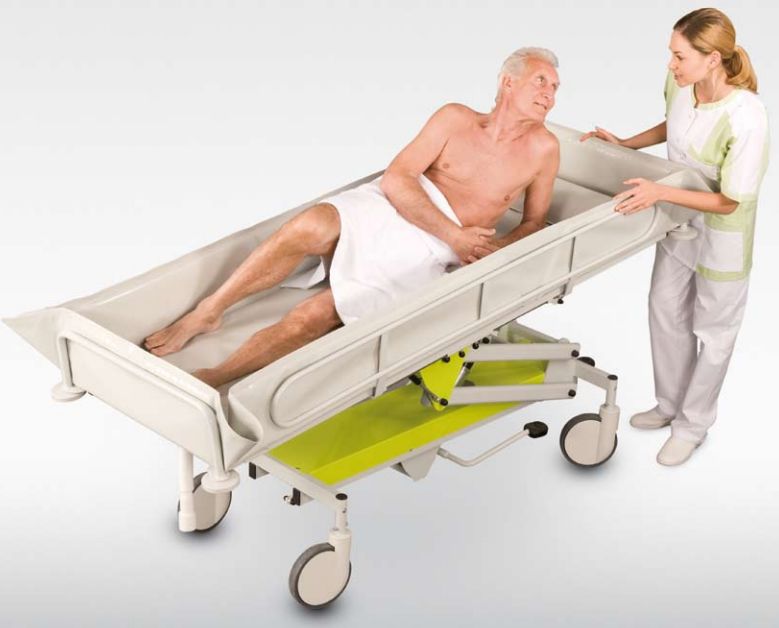 Written by Hulet Smith, OT
Written by Hulet Smith, OT
A shower gurney, also known as shower bed or shower trolley, is a water-resistant, mobile, medical device that allows a caregiver to easily and safely transport a patient with limited body movement into a bathing area like a shower. Once transferred to the bathing area, the patient will remain lying on the shower gurney while the caregiver tends to their hygiene needs. Some shower gurneys allow the caregiver to bathe the patient on the gurney itself without the use of a bathing area, making them perfect for areas where a medical facility-style bathing area is not available.
Providing caregivers with a safe and discreet way to administer personal hygiene to their patients is vital for both the caregiver and the patient. Keeping the patient clean is important in preventing and combating illness as well being essential for their self-esteem, while the ability to accomplish this task with safe, quick, and easy facilitation is beneficial for the caregiver, while also maintaining the comfort of the patient.
A person who is bedridden may often find it difficult to maintain their personal hygiene standards by themselves and will, therefore, require the assistance of a caregiver. Using a shower gurney is a well-proven, safe, and more enjoyable alternative for bathing a person than performing a bed bath, or causing possible harm by having to manually move them to a shower stall or bathtub.
Using a shower gurney is easy for both the caregiver and patient. The gurney is simply rolled up next to the bed and then brought to the same height as the patient’s mattress. This can either be accomplished by adjusting the height of the gurney or by adjusting the height of the bed depending on the features of each. Once the height of the two surfaces is leveled, the patient can then safely be transferred from one to the other either independently or with the assistance of a slide sheet or other transfer device. Once the transfer is complete, the patient, while still laying flat, can then be safely transported into a shower area.

Shower gurneys are all basically designed to accomplish the same task, providing the best and safest way for caregivers to maintain the cleanliness of their patients. When you’re choosing a shower gurney, there are a variety of features and options that will best meet the specific needs of the patient and caregiver as well as fulfilling the physical parameters of the facility or home where the patient resides.
First things first, a shower gurney must have strong and water-resistant material for both the frame and pad construction. Many shower gurney frames are built with heavy-duty, yet lightweight, water-resistant PVC pipe that is chip- and scratch-resistant, while other gurney frames are designed for strength, constructed with powder-coated stainless steel or a combination of stainless steel and zinc-plated steel.
Shower gurneys often include waterproof, closed-cell foam pads with drainage holes that allow water to drain directly onto the shower floor. Alternatively, some designs are configured with a drain pan to catch the wastewater and direct it with a flexible drainage hose located beneath the stretcher into a floor drain hole or toilet. Either way, most designs direct water away from the patient to ensure comfort and cleanliness.
In addition to ensuring an enjoyable showering experience for both patient and caregiver, shower gurneys need to be easy to clean themselves so that they never get in the way of the user’s own cleanliness. Several gurneys will offer splash guards on the side rails that enable the patient to be bathed inside the shower gurney, and some include pads that are designed to be easy to clean while also inhibiting bacterial growth.
Since a major component of a shower gurney’s function is mobility, determining the right type of waterproof casters to suit your needs is important. All shower gurney casters highlight no-rust capabilities for long-lasting use in wet environments, and come in different sizes from 5-inch Tente casters to robust 7.87 diameter casters that allow the gurney to be transported safely over different surfaces.
Additionally, for increased versatility, some gurneys have a combination of two braking casters and two straight-steering castors to provide both easy traveling and a secure stationary platform. For gurneys that have higher weight capacities, they might also include middle casters to help eliminate central sagging and also increase maneuverability.
Most shower gurneys feature a weight capacity of at least 300 pounds or more, but a variety of options feature weight capacities ranging from 374 pounds, 450 pounds, and even up to 600 or 1000 pounds to best fit the needs of each unique patient.
Regardless of your final choice, it's important to select a gurney that is rated for a weight capacity significantly higher than your patient's normal weight range, allowing space for regular fluctuations.
Side rails are another important safety consideration for a shower gurney, as gurneys are used to transport patients over longer distances through a facility or home. Side rails are designed to keep patients safely within the borders of the gurney’s surface and are often curved to provide support without their edges harming the patient or the caregiver. They are also usually able to fold or slide down out of the way for easy patient transfer, and can then be brought back up and locked for secure containment.
Additionally, some shower gurneys also include a side-mounted column that allows the gurney to be brought flush up to the bed height, and overlapping with the bed mattress. This enables the rails to either be lowered or tilted out flat on the bed to provide an even surface for the caregiver to safely slide the patient onto the shower gurney. Wider bariatric gurneys have rails that will fold inward to reduce the width of the gurney so that it can more easily fit through narrow doorways.
Some models of shower gurneys are height adjustable, either by using a manual hydraulic system or with electric/battery operated hand pendants or foot control pedals and bars that cater to the caregiver’s preference. Some gurneys also offer the ability to tilt the gurney, including Trendelenburg positioning, providing the patient and caregiver with added comfort, and facilitating fluid drainage.
To provide extra patient comfort and enhanced water drainage from the head of the gurney, some shower gurneys provide the added option of a three-position or five-position elevated headrest that allows the patient to view the surrounding area and to keep the water away from the nose and mouth while bathing.

In addition to those features common to most if not all shower gurneys, a variety of specific accessories and features are available to choose from, ensuring a shower gurney choice that will best meet the needs of the facility, caregiver, and most importantly, the patient.
A folding shower gurney includes ends that fold up to shorten the bed length to a mere 42-inches, saving up to nine square feet of storage space when it’s not being used. The foldable design makes it perfect for use in smaller facilities or for a home environment when space is limited.
Additionally, for battery-operated adjustable gurneys, knowing if the battery is embedded into the gurney and is chargeable via a magnetic battery charger connection or if it can be removed for remote charging might be important when considering the room’s electrical set-up.
In addition, other design highlights that will assist the patient and caregiver include a gurney with an IV pole mounting bracket or wedge positioning pillows in either 15 or 30-degree angles for help arranging the patient into the best position for comfort and hygiene.
In summary, people who are bedridden or have mobility limitations due to age, disease, accident, injury, or surgery benefit from having continued good personal hygiene, and a shower gurney is the perfect way to ensure this hygiene is maintained.
The many different styles of shower gurneys offer a functional and safe washing environment for both the patient and caregiver, while also fitting easily within the parameters of the medical facility or home. Everybody deserves to feel clean, and using a shower gurney is a safe and easy way to maintain personal hygiene for anyone who needs mobility assistance.

Co-founder/CEO of Rehabmart, Pediatric Occupational Therapist, husband, and father. Passionate about connecting special needs kids with superb nutrition, sensory integration, and complementary health strategies. Excited about Rehabmart's mission to become the premier online educational platform which empowers caregivers by spotlighting innovative devices and interventions to achieve optimal patient response and recovery.